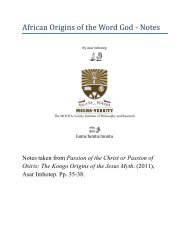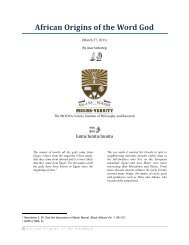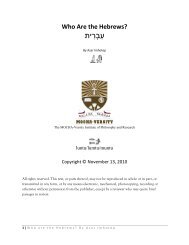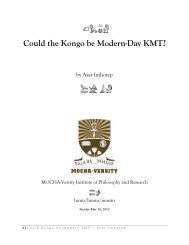reinterpretations of the ankh symbol part 2 - Asar Imhotep
reinterpretations of the ankh symbol part 2 - Asar Imhotep
reinterpretations of the ankh symbol part 2 - Asar Imhotep
Create successful ePaper yourself
Turn your PDF publications into a flip-book with our unique Google optimized e-Paper software.
26<br />
ropes in Africa was an ancient practice that ritually bound <strong>the</strong> persons tying <strong>the</strong> knots to <strong>the</strong><br />
commitments <strong>the</strong>y have made. It should be noted that <strong>the</strong> Egyptian word for “vertebra” ts literally<br />
means “knot.” 18 This may be relevant given our connection between <strong>the</strong> anx and <strong>the</strong> spinal column<br />
and why <strong>the</strong> anx is depicted as a knotted piece <strong>of</strong> rope.<br />
In terms <strong>of</strong> <strong>the</strong> process <strong>of</strong> breathing, I <strong>of</strong>fer <strong>the</strong> following as a possible interpretation. It is my<br />
current belief that <strong>the</strong> above image, outside <strong>of</strong> its political connotations, simply speaks to <strong>the</strong><br />
process <strong>of</strong> respiration and how blood, oxygen, <strong>the</strong> lungs and arteries work as a coherent system to<br />
maintain life. Given our understanding <strong>of</strong> how African myths are created in <strong>Imhotep</strong> (2011), what I<br />
would suggest is that one pay attention to “who” is doing <strong>the</strong> tying as this can be very important in<br />
terms <strong>of</strong> a proper interpretation.<br />
Heru and Set may represent important features in <strong>the</strong> process <strong>of</strong> breathing for which I cannot<br />
decipher at this time. Set in <strong>the</strong> above image is holding <strong>the</strong> lotus plant (Nelumbo nucifera) which<br />
allegedly was introduced from Persia. The Blue Lotus (Nymphaea Caerulea) is native to Egypt and<br />
has been proven to have some psychoactive and physiological effects on <strong>the</strong> body. It was used as a<br />
“visionary” enhancer and was taken ei<strong>the</strong>r by way <strong>of</strong> smoking it or brewing it in teas or alcohol<br />
(wine being <strong>the</strong> favorite). It was seen as <strong>the</strong> key to good health, sex and rebirth. The Blue Lotus was<br />
an aphrodisiac and enhanced sexual vigor like Viagra, was used as a pain killer like Arnica, a tonic<br />
like Ginseng, and circulation stimulant like Ginkgo Biloba. 19 With this in mind, what we could be<br />
looking at is a possible recipe used to invigorate one’s sexual life, unblock blockages, or ingredients<br />
used to promote optimum health. The key is in researching <strong>the</strong> possible health benefits <strong>of</strong> <strong>the</strong><br />
papyrus plant if it was ever consumed to see if it had in medicinal purposes. One could be reading<br />
too much into this, but it wouldn’t hurt to explore <strong>the</strong> possibilities.<br />
To <strong>the</strong> right we can see ano<strong>the</strong>r version <strong>of</strong> this<br />
relief where <strong>the</strong> anx association is more vivid. As we<br />
can see, <strong>the</strong> Snw h acts as <strong>the</strong> “loop” aspect <strong>of</strong> <strong>the</strong><br />
anx and <strong>the</strong> trachea acts as <strong>the</strong> vertical bar <strong>of</strong> <strong>the</strong> anx<br />
verifying and confirming our association between<br />
<strong>the</strong> anx and <strong>the</strong> thoracic complex.<br />
There is ano<strong>the</strong>r version <strong>of</strong> this same image, but <strong>the</strong><br />
gods Hrw and St are not doing <strong>the</strong> tying: it is <strong>the</strong><br />
god Hapi (Abbey) which is a personification <strong>of</strong> <strong>the</strong><br />
Nile River (which is why he is depicted in a blue<br />
color).<br />
18 ts n psd “dorsal vertebrae”; ts n nhbt “cervical vertebrae”<br />
19 Nymphaea caerulea - Water Lily / Blue Lotus<br />
http://www.en<strong>the</strong>ology.org/edoto/anmviewer.asp?a=65&z=6. See also, Nymphaea caerulea<br />
http://en.wikipedia.org/wiki/Nymphaeacaerulea






